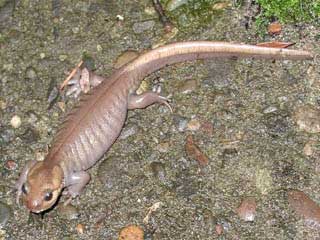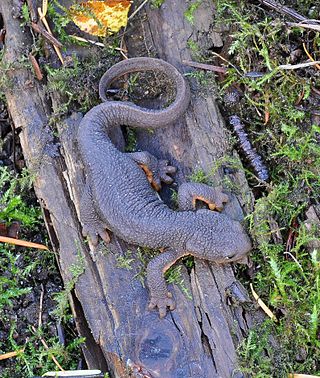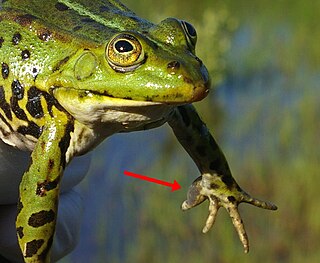
Salamanders are a group of amphibians typically characterized by their lizard-like appearance, with slender bodies, blunt snouts, short limbs projecting at right angles to the body, and the presence of a tail in both larvae and adults. All ten extant salamander families are grouped together under the order Urodela from the group Caudata. Urodela is a scientific Latin term based on the Ancient Greek οὐρά δήλη: ourà dēlē "conspicuous tail". Caudata is the Latin for "tailed ones", from cauda: "tail".

The northwestern salamander is a species of mole salamander that inhabits the northwest Pacific coast of North America. These fairly large salamanders grow to 8.7 in (220 mm) in length. It is found from southeastern Alaska on May Island, through Washington and Oregon south to the mouth of the Gualala River, Sonoma County, California. It occurs from sea level to the timberline, but not east of the Cascade Divide. Its range includes Vancouver Island in British Columbia and The San Juan Islands, Cypress, Whidbey, Bainbridge, and Vashon Islands in Washington.

The genus Taricha consists of four species of highly toxic newts in the family Salamandridae. Their common name is Pacific newts, sometimes also western newts or roughskin newts. The four species within this genus are the California newt, the rough-skinned newt, the red-bellied newt, and the sierra newt, all of which are found on the Pacific coastal region from southern Alaska to southern California, with one species possibly ranging into northern Baja California, Mexico.

The rough-skinned newt or roughskin newt is a North American newt known for the strong toxin exuded from its skin.

The California newt or orange-bellied newt, is a species of newt endemic to California, in the Western United States. Its adult length can range from 5 to 8 in. Its skin produces the potent toxin tetrodotoxin.

The northern slimy salamander is a species of terrestrial plethodontid salamander found throughout much of the eastern two-thirds of the United States.

The Sierra newt is a newt found west of the Sierra Nevada, from Shasta county to Tulare County, in California, Western North America.
Atelopus oxyrhynchus is a species of toad in the family Bufonidae. It is endemic to Venezuela. Its natural habitats are subtropical or tropical moist montane forests, rivers, and intermittent rivers. It is threatened by habitat loss.

The Scott Bar salamander is a species of salamander in the family Plethodontidae, endemic to the United States, where it is restricted to a very small range in the Scott River drainage in Siskiyou County, California, at altitudes between 700 and 1,300 metres above sea level. Described in 2005, it is one of the most recently described species in the large genus Plethodon.

A newt is a salamander in the subfamily Pleurodelinae. The terrestrial juvenile phase is called an eft. Unlike other members of the family Salamandridae, newts are semiaquatic, alternating between aquatic and terrestrial habitats. Not all aquatic salamanders are considered newts, however. More than 100 known species of newts are found in North America, Europe, North Africa and Asia. Newts metamorphose through three distinct developmental life stages: aquatic larva, terrestrial juvenile (eft), and adult. Adult newts have lizard-like bodies and return to the water every year to breed, otherwise living in humid, cover-rich land habitats.
The Crater Lake newt or Mazama newt, Taricha granulosa mazamae, is a subspecies of the rough-skinned newt. Its type locality is Crater Lake, Oregon. Similar newts have been found in Alaska, but their identity is unclear.

A nuptial pad is a secondary sex characteristic present on some mature male frogs and salamanders. Triggered by androgen hormones, this breeding gland appears as a spiked epithelial swelling on the forearm and prepollex that aids with grip, which is used primarily by males to grasp females during amplexus. They can also be used in male–male combat in some species.

The Bedded Range is a mountain range in the Hozameen Range subdivision of the Canadian Cascades, which are the extension of the Cascade Range into British Columbia, Canada. Located between the Coquihalla and Tulameen Rivers, the Bedded Range is a dioritic plug related to the Chilliwack batholith.

There are 14 species of amphibians and 5 species of reptiles known to occur in Mount Rainier National Park.












